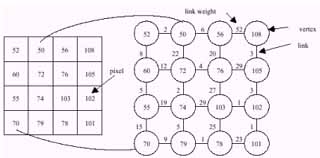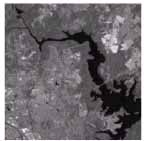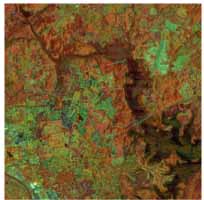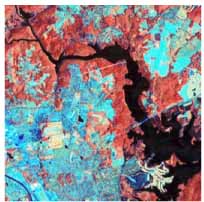| GISdevelopment.net ---> AARS ---> ACRS 2000 ---> Image Processing |
Color Image Enhancement based
on Segmentation Region Histogram Equalization
Sakreya. CHITWONG, Fusak CHEEVASUVIT,
Kobchai DEJHAN and Somsak MITATHA
Faculty of Engineering and Research Center for Communication and Information Technology,
King Mongkut's Institute of Technology Ladkrabang, Ladkrabang, Bangkok 10520, Thailand.
Tel : 66-2-3269967, 66-2-3269081, Fax : 66-2-3269086
E-mail :http://www.gisdevelopment.net/aars/acrs/2000/ts9/kobchai@telelan.telecom.kmitl.ac.th
Sakreya. CHITWONG, Fusak CHEEVASUVIT,
Kobchai DEJHAN and Somsak MITATHA
Faculty of Engineering and Research Center for Communication and Information Technology,
King Mongkut's Institute of Technology Ladkrabang, Ladkrabang, Bangkok 10520, Thailand.
Tel : 66-2-3269967, 66-2-3269081, Fax : 66-2-3269086
E-mail :http://www.gisdevelopment.net/aars/acrs/2000/ts9/kobchai@telelan.telecom.kmitl.ac.th
Keywords: edge preserving smoothing, local and
global histogram equalization, segmentation, graph theory
Abstract
Histogram modification is a classical method for image enhancement, especially histogram equalization. Histogram equalization method is a self-acting process since it does notrequest any information, just only the probability of each intensity level of image. However, the enhanced image is obtained by the global area histogram equalization will cause an effect of intensity saturation in some areas. This defeat is appeared because of the process attempted to merge the adjacent gray levels together in order to flatten the histogram. To reduce the mentioned defeat, a method of local area histogram equalization is proposed. First, the original image will be partitioned into small areas by using graph theory, since the graph theory gives high accurately boundaries of region. The histogram of all pixels in each segmented region will be equalized independently. The method of segmented region histogram equalization will be applied to each scene of multi-spectral satellite imageries. The enhanced color image can be accomplished by assigning the color of red, green and blue to 3 different spectral images. The resulting of obtained color image from the proposed method is obviously shown the details more than the traditional method.
1. Introduction
The enhancement techniques are employed in order to increase the contrast of an image. Therefore, the distinction of features in the scene can be easily performed by visualization. This will augment the efficiency of image classification and interpretation. Generally, an image can be enhanced by spreading out the range of scene illumination. This procedure is called contrast stretch. If the ranges of gray values are uniformly prolonged, the process will be called linear contrast stretch. The disadvantage of the linear contrast stretch is that a number of gray levels are equally assigned to the unusually appeared gray levels as to the often appeared gray levels. This effect still causes the ambiguous distinction of the similar features. To overcome the mention defect, the process of histogram equalization is applied. The process tries to assigned more number of gray levels to the frequency appeared gray levels. The enhanced image obtained from the global area histogram equalization will cause an effect of intensity saturation in darkness area and whiteness areas. This drawback is appeared because of the process attempted to agglomerate the adjacent gray levels together in order to flatten the histogram. To overcome this defect, we proposed a method of local area histogram equalization. The process will be, first partitioned the original image into small area by graph theory. Then the histogram of each segmented region will be equalized independently. This process is applied to the multispectral images. The color image enhancement will be obtained by encoding the color of red, green and blue to three different spectral images. The detail of the proposed algorithm can be described as the following paragraph.
2. Image Segmentation By Graph Theory
The aim of image segmentation is to divide the scene into significance regions. The adjacent similar pixels will be grouped together into the same region. Then the interested objects will be isolated from each and other. Therefore the segmented image can be applied to widely application such as feature classification, object detection, motion estimation, data compression etc. However the noise pixels always presented in an image. These noises will cause an ambiguity in feature classification by segmented image, since the isolated small regions will be spread out over the interested features. So the edge preserving smoothing method of (S. Chitwong, et al., 2000) will be applied to cancel these noise pixels. The smoothing algorithm not only eliminates the noise but also accentuate the boundaries of the separated region. For obtaining the high accurate region's boundaries in the segmented image , the segmentation via graph theory (O.J. Morris,et al., 1986) has been chosen. The segmentation procedure can be manifested as the following steps.
1. Mapping one by one of each pixel in image onto a vertex of graph, where the gray level of the pixel is the vertex weight of the graph. The mapping result can be shown in Fig. 1.

Fig. 1 Image and corresponding graph
2. Each pixel will be linked to its neighbor in 4 perpendicular directions and each link weight is obtained by the absolute different of vertex weight between two connected vertices.
3. Merge two adjacent vertices together to form an homogeneous region. The link weight is used to verify the resemblance of the adjacent pixels. The average value of merging vertices will be assigned to the pixel group and the concerned link weight will be recalculated.
4. For obtaining M+1 segmented regions in the image, the last M links will be cut.
3. Histogram Equalization
The histogram equalization is applied in order to improve the contrast of image. Therefore, the histogram of each segmented region will be modified by local histogram equalization process in order to reduce the effect of intensity saturation which obtained from the global histogram equalization.
4. Implementation Result
The edge preserving smoothing process is applied to the original images Fig. 2. The graph theory is employed for segmenting the images of Fig.2. The histogram of each segmented region will be equalized independently. By assigning the color red, green and blue to processed image. The result of color image enhancement is shown in Fig.3(a). While the traditional method of global histogram equalization is presented in Fig.3(b).
Fig.2 Original TM image
Fig.3 Colour
image (a) Colour image from local area histogram equalization (b) Colour
image from global histogram equalization
5. Conclusion
Histogram equalization is powerful method for increasing the contrast of image. The enhanced image will give the full dynamic range of histogram. However, the global histogram equalization process tries to merge the adjacent gray levels together in order to force the uniformity of number of pixels in each appeared gray levels. Consequently, the intensity saturation will be presented in darkness regions and whiteness region. Also the pixels located in the border of two regions which are not too different in gray levels will be grouped together. But, for our propose, we separate out these two regions first and then exploit the histogram equalization to each region independently. Therefore, the mentioned defects can be overcome.
References
Abstract
Histogram modification is a classical method for image enhancement, especially histogram equalization. Histogram equalization method is a self-acting process since it does notrequest any information, just only the probability of each intensity level of image. However, the enhanced image is obtained by the global area histogram equalization will cause an effect of intensity saturation in some areas. This defeat is appeared because of the process attempted to merge the adjacent gray levels together in order to flatten the histogram. To reduce the mentioned defeat, a method of local area histogram equalization is proposed. First, the original image will be partitioned into small areas by using graph theory, since the graph theory gives high accurately boundaries of region. The histogram of all pixels in each segmented region will be equalized independently. The method of segmented region histogram equalization will be applied to each scene of multi-spectral satellite imageries. The enhanced color image can be accomplished by assigning the color of red, green and blue to 3 different spectral images. The resulting of obtained color image from the proposed method is obviously shown the details more than the traditional method.
1. Introduction
The enhancement techniques are employed in order to increase the contrast of an image. Therefore, the distinction of features in the scene can be easily performed by visualization. This will augment the efficiency of image classification and interpretation. Generally, an image can be enhanced by spreading out the range of scene illumination. This procedure is called contrast stretch. If the ranges of gray values are uniformly prolonged, the process will be called linear contrast stretch. The disadvantage of the linear contrast stretch is that a number of gray levels are equally assigned to the unusually appeared gray levels as to the often appeared gray levels. This effect still causes the ambiguous distinction of the similar features. To overcome the mention defect, the process of histogram equalization is applied. The process tries to assigned more number of gray levels to the frequency appeared gray levels. The enhanced image obtained from the global area histogram equalization will cause an effect of intensity saturation in darkness area and whiteness areas. This drawback is appeared because of the process attempted to agglomerate the adjacent gray levels together in order to flatten the histogram. To overcome this defect, we proposed a method of local area histogram equalization. The process will be, first partitioned the original image into small area by graph theory. Then the histogram of each segmented region will be equalized independently. This process is applied to the multispectral images. The color image enhancement will be obtained by encoding the color of red, green and blue to three different spectral images. The detail of the proposed algorithm can be described as the following paragraph.
2. Image Segmentation By Graph Theory
The aim of image segmentation is to divide the scene into significance regions. The adjacent similar pixels will be grouped together into the same region. Then the interested objects will be isolated from each and other. Therefore the segmented image can be applied to widely application such as feature classification, object detection, motion estimation, data compression etc. However the noise pixels always presented in an image. These noises will cause an ambiguity in feature classification by segmented image, since the isolated small regions will be spread out over the interested features. So the edge preserving smoothing method of (S. Chitwong, et al., 2000) will be applied to cancel these noise pixels. The smoothing algorithm not only eliminates the noise but also accentuate the boundaries of the separated region. For obtaining the high accurate region's boundaries in the segmented image , the segmentation via graph theory (O.J. Morris,et al., 1986) has been chosen. The segmentation procedure can be manifested as the following steps.
1. Mapping one by one of each pixel in image onto a vertex of graph, where the gray level of the pixel is the vertex weight of the graph. The mapping result can be shown in Fig. 1.

Fig. 1 Image and corresponding graph
2. Each pixel will be linked to its neighbor in 4 perpendicular directions and each link weight is obtained by the absolute different of vertex weight between two connected vertices.
3. Merge two adjacent vertices together to form an homogeneous region. The link weight is used to verify the resemblance of the adjacent pixels. The average value of merging vertices will be assigned to the pixel group and the concerned link weight will be recalculated.
4. For obtaining M+1 segmented regions in the image, the last M links will be cut.
3. Histogram Equalization
The histogram equalization is applied in order to improve the contrast of image. Therefore, the histogram of each segmented region will be modified by local histogram equalization process in order to reduce the effect of intensity saturation which obtained from the global histogram equalization.
4. Implementation Result
The edge preserving smoothing process is applied to the original images Fig. 2. The graph theory is employed for segmenting the images of Fig.2. The histogram of each segmented region will be equalized independently. By assigning the color red, green and blue to processed image. The result of color image enhancement is shown in Fig.3(a). While the traditional method of global histogram equalization is presented in Fig.3(b).
 (a) band 4 |
 (b) band 4 |
 (c) band 4 |
 (a) |
 (b) |
5. Conclusion
Histogram equalization is powerful method for increasing the contrast of image. The enhanced image will give the full dynamic range of histogram. However, the global histogram equalization process tries to merge the adjacent gray levels together in order to force the uniformity of number of pixels in each appeared gray levels. Consequently, the intensity saturation will be presented in darkness regions and whiteness region. Also the pixels located in the border of two regions which are not too different in gray levels will be grouped together. But, for our propose, we separate out these two regions first and then exploit the histogram equalization to each region independently. Therefore, the mentioned defects can be overcome.
References
- P.W. Fung, K.K. Ly, and Y. Attikiouzed, 1988. Automatic segmentation
of biomedical image. Proc ICASSP, pp. 882-885.
- F. Tomita and S. Tsuji, 1977. Extraction of multiple regions by
smoothing in selected neighbourhood. IEEE Trans. System Man and
Cybernetics SMC-7, pp. 107-109.
- M. Nagao and T. Matsuyama, 1979. Edge preserving smoothing. Computer
Graphics and Image Processing, vol.9, pp. 374-407.
- S. Chitwong, F. Cheevasuvit, K. Dejhan, S. Mitatha, C. Nokyoo and T.
Paungma, 2000 Segmentation on Edge Preserving Smoothing Image based on
Graph Theory. Proceeding of IGARSS 2000, July.
- S.L. Horowitz and T. Pavlidis, 1974. Picture segmentation by a
directed split-and-merge procedure. Proc. 2 nd Int. Joint Conf. on
Pattern Recognition, pp. 424-433.
- F. Cheevasuvit, H. Maitre and D. Vidal-Madjar, 1986. A robust method
for picture segmentation based on a split-and-merge procedure. Computer
Vision, Graphics and image processing, vol. 34, pp. 268-281.
- J.B. Jun Kruskal, 1956. On the shortest spanning subtree of a graph
and the travelling saleman problem. Proc. Am. Math. Soc., vol. 7, pp.
48-50.
- D. Cheriton and R.E. Tarjan, 1967. Finding minimum spanning trees.
SIAM J. Comput., vol. 5, pp. 724-742.
- O.J. Morris, M.de J. Lee, and A.G. Constantinides, 1986. Graph
theory for image analysis : an approach based on the shortest spanning
tree. Proc. IEE, vol. 133, pt. F, no. 2, pp.146-15.
- O.J. Morris, M.de J.Lee, and A.G. Constantinides, 1986. A unified
method for segmentation and edge detection using graph theory. Proc.
ICASSP, pp. 2051-2054.